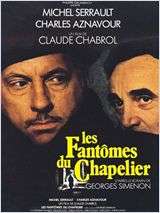The Hatter's Ghost
| The Hatter's Ghost | |
|---|---|
 Theatrical release poster | |
| Directed by | Claude Chabrol |
| Screenplay by | Claude Chabrol |
| Based on |
Les fantômes du chapelier by Georges Simenon |
| Starring |
Michel Serrault Charles Aznavour Monique Chaumette |
| Music by | Matthieu Chabrol |
| Cinematography | Jean Rabier |
| Edited by | Monique Fardoulis |
Production company |
Philippe Grumbach Productions S.F.P.C. Films A2 |
Release dates | 25 May 1982 |
Running time | 120 min. |
| Country | France |
| Language | French |
| Box office | $2.9 million[1] |
The Hatter's Ghost (French: "Les fantômes du chapelier") is a 1982 film directed by Claude Chabrol. It is based on the 1947 story Le Petit Tailleur et le Chapelier by Georges Simenon. The film takes place in Brittany and was shot in the towns of Concarneau and Quimper.
Plot
Labbé, a hatter in a French provincial town, leads the life of a respectable citizen but is in fact a serial murderer. The only person to suspect this is his neighbour Kachoudas, an Armenian tailor. After the hatter kills his own wife, he then kills six of her friends to stop them visiting her and prepares to murder a seventh when the intended victim dies naturally. As a substitute, he murders the maid. At the same time, Kachoudas is dying and Labbé confesses his crime to him. Then, after getting drunk he visits his favourite prostitute Berthe and kills her too, being found there in the morning by the police.
Principal cast
| Actor | Role |
|---|---|
| Michel Serrault | Léon Labbé |
| Charles Aznavour | Kachoudas |
| Monique Chaumette | Madame Labbé |
| François Cluzet | Jeantet |
| Isabelle Sadoyan | Alice Kachoudas |
| Jean Champion | Senator Laude |
| Bernard Dumaine | Arnoult |
| Aurore Clément | Berthe |
Critical reception
TV Guide rated the film with 2 1/2 out of 5 stars and commented:
| “ | Another Claude Chabrol film that neither fails nor lives up to his previous successes (LES BICHES, among others). Again he pays homage to Hitchcock with a psychopath, Michel Serrault, who murders his wife, then kills six of her elderly friends.[2] | ” |
From Time Out London:
| “ | The hatter (Serrault) is a mass strangler who allows his secret to be discovered by hangdog Cachoudas (Aznavour), the tubercular Armenian tailor opposite. The ensuing relationship seems unbelievably reckless, even with a mad hatter involved, and manifestly it's the Hitchcocko-Jesuitical theology about shared guilt which animates the picture... Chabrol locates his adaptation in an off-kilter time zone - little bit '30s, little bit '50s - that some may find the most intriguing aspect of the movie.[3] | ” |
References
- ↑ http://www.jpbox-office.com/fichfilm.php?id=7138
- ↑ "The Hatter's Ghost Review". Movies.tvguide.com. Retrieved 2011-11-01.
- ↑ "Les Fantômes du Chapelier Review. Movie Reviews - Film - Time Out London". Timeout.com. Retrieved 2011-11-01.